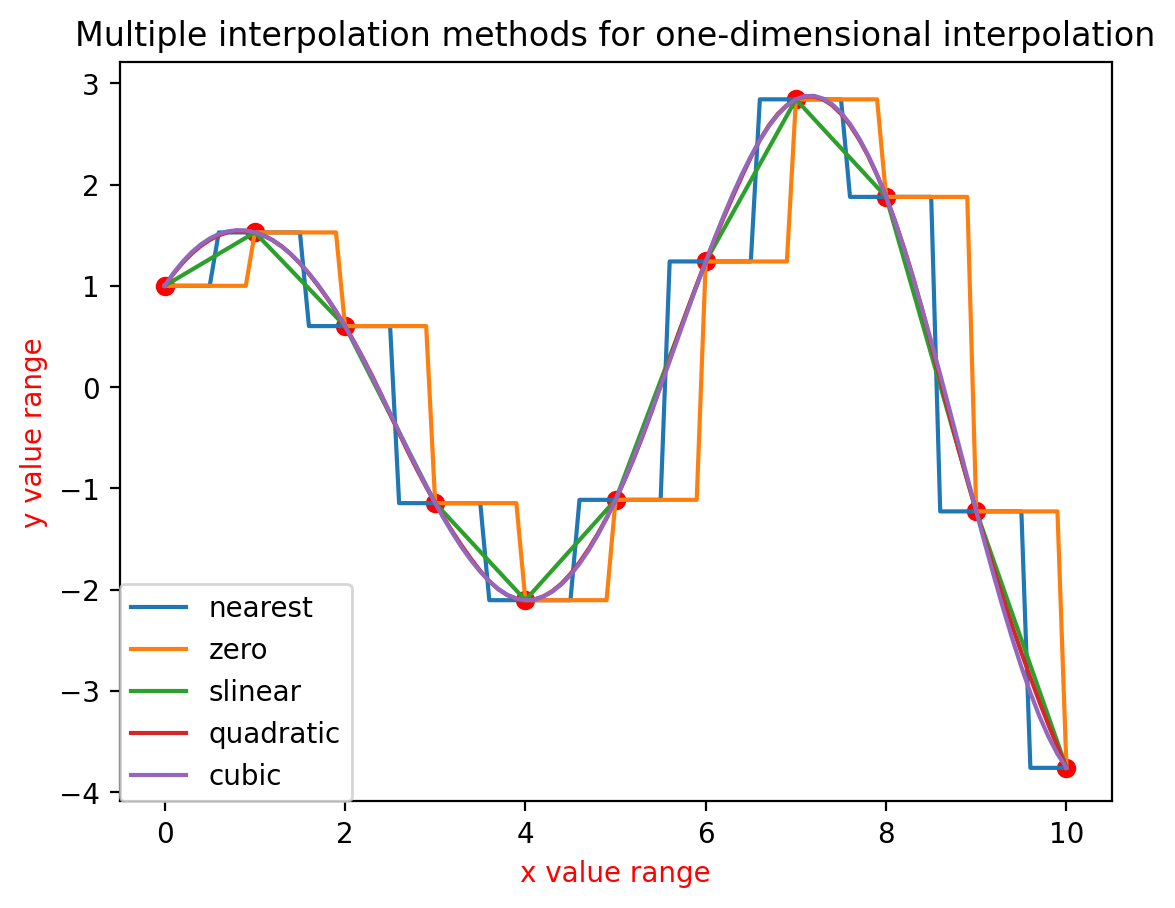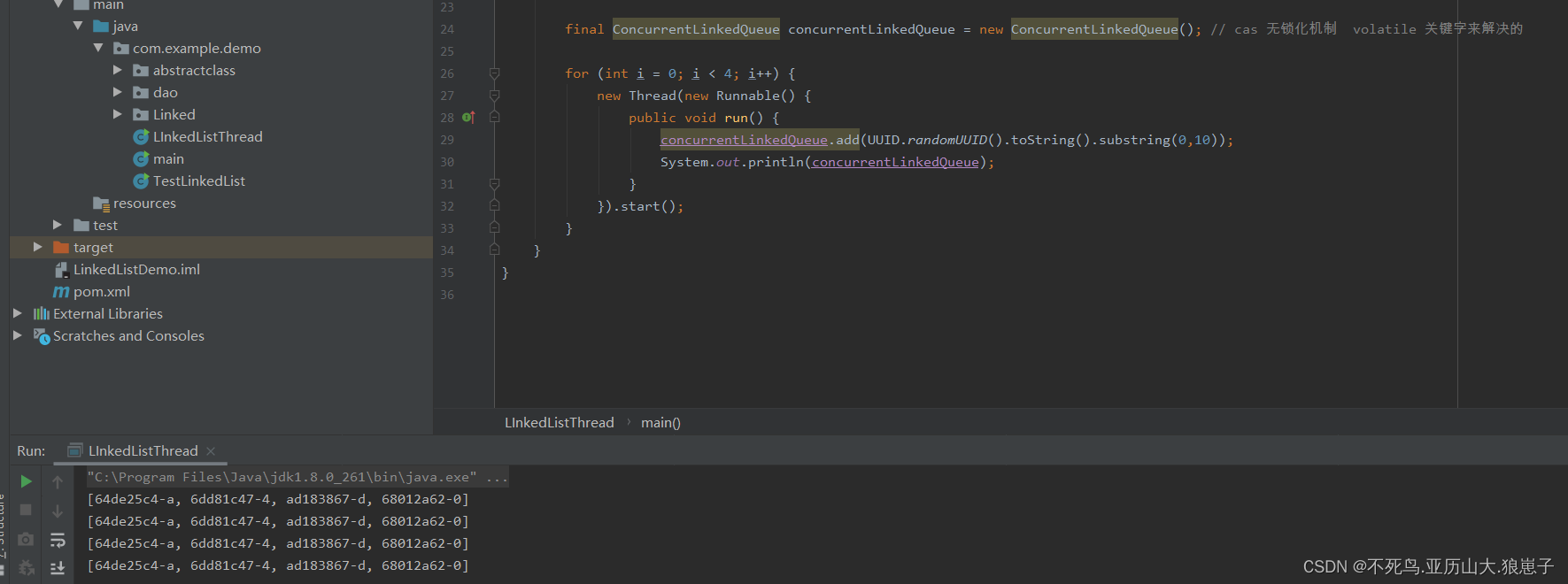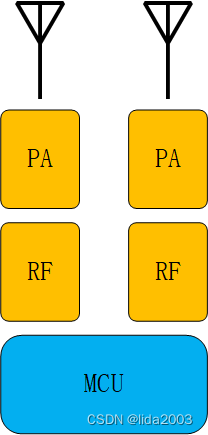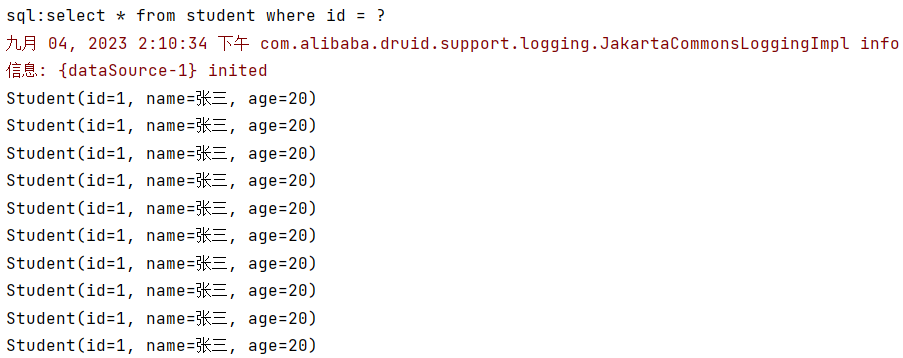参考:驱动程序开发:SPI设备驱动_spi驱动_邓家文007的博客-CSDN博客
目录
一、SPI驱动简介
1.1 SPI架构概述
1.2 SPI适配器(控制器)数据结构
1.2 SPI设备数据结构
1.3 SIP设备驱动
1.4 接口函数
二、SPI驱动模板
一、SPI驱动简介
SPI驱动框架和I2C驱动框架是十分相似的,不同的是因为SPI是通过片选引脚来选择从机设备的,因此SPI不再需要像I2C那样先进行寻址操作(查询从机地址)后再进行对应寄存器的数据交互,并且SPI是全双工通信,通信速率要远高于I2C。
但是SPI显然占用的硬件资源也比I2C要多,并且SPI没有了像I2C那样指定的流控制(例如开始、停止信号)和没有了像I2C应当机制(导致无法确认数据是否接收到了)。
1.1 SPI架构概述
Linux的SPI体系结构可以分为3个组成部分:
- spi核心(SPI Core):SPI Core是Linux内核用来维护和管理spi的核心部分,SPI Core提供操作接口函数,允许一个spi master,spi driver和spi device初始化时在SPI Core中进行注册,以及退出时进行注销。
- spi控制器驱动或适配器驱动(SPI Master Driver):SPI Master针对不同类型的spi控制器硬件,实现spi总线的硬件访问操作。SPI Master 通过接口函数向SPI Core注册一个控制器。
- spi设备驱动(SPI Device Driver):SPI Driver是对应于spi设备端的驱动程序,通过接口函数向SPI Core进行注册,SPI Driver的作用是将spi设备挂接到spi总线上。
Linux的软件架构图如下图所示:
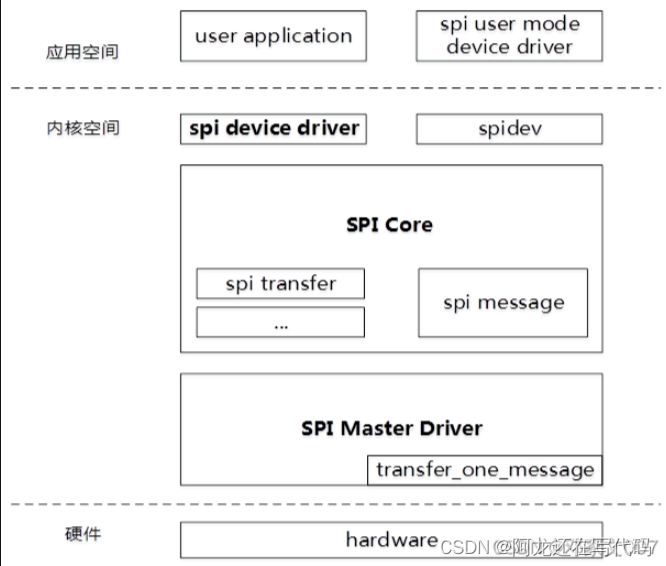
1.2 SPI适配器(控制器)数据结构
参考内核文件:include/linux/spi/spi.h
Linux中使用spi_master结构体描述SPI控制器,里面最重要的成员就是transfer函数指针:

transfer 函数,和 i2c_algorithm 中的 master_xfer 函数一样,控制器数据传输函数。
transfer_one_message 函数,也用于 SPI 数据发送,用于发送一个 spi_message,SPI 的数据会打包成 spi_message,然后以队列方式发送出去。
1.2 SPI设备数据结构
参考内核文件:include/linux/spi/spi.h
Linux中使用spi_device结构体描述SPI设备,里面记录有设备的片选引脚、频率、挂在哪个SPI控制器下面: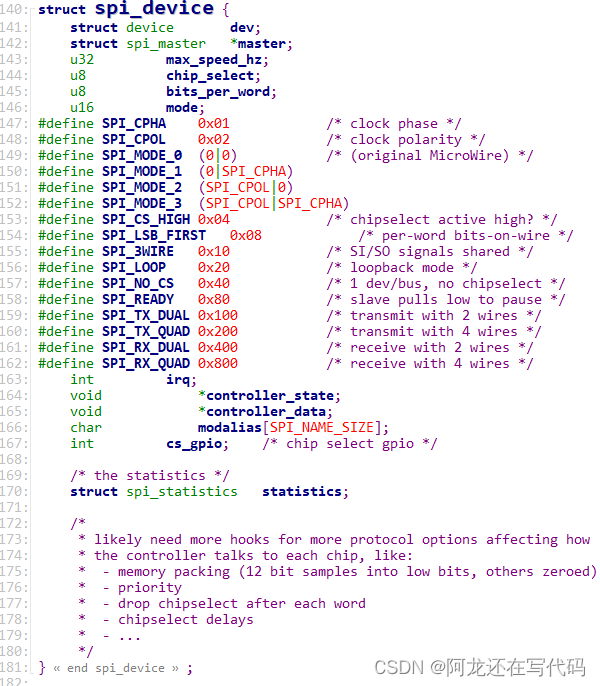
1.3 SIP设备驱动
参考内核文件:include/linux/spi/spi.h
Linux中使用spi_driver结构体描述SPI设备驱动:
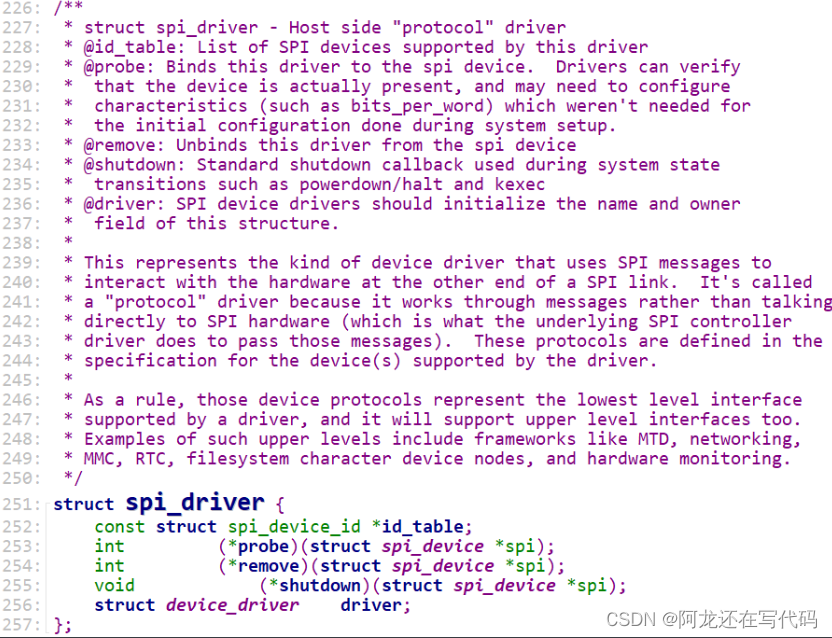
可以看出,spi_driver 和 i2c_driver、 platform_driver 基本一样,当 SPI 设备和驱动匹配成功以后 probe 函数就会执行。
比如:spi1下面接有两个设备(有两个片选信号),我们就可以把设备放入子节点里面,子节点将有内核解析后转换成一个spi_device,与某一个spi_driver匹配后,spi_driver里的probe函数就被调用,我们在probe函数里就可以注册字符设备驱动程序。
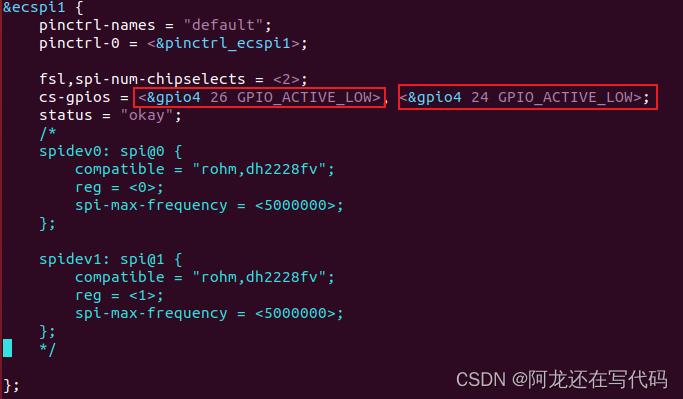
1.4 接口函数
函数原形:
- 简易函数
/*** SPI同步写* @spi: 写哪个设备* @buf: 数据buffer* @len: 长度* 这个函数可以休眠** 返回值: 0-成功, 负数-失败码*/
static inline int
spi_write(struct spi_device *spi, const void *buf, size_t len);/*** SPI同步读* @spi: 读哪个设备* @buf: 数据buffer* @len: 长度* 这个函数可以休眠** 返回值: 0-成功, 负数-失败码*/
static inline int
spi_read(struct spi_device *spi, void *buf, size_t len);/*** spi_write_then_read : 先写再读, 这是一个同步函数* @spi: 读写哪个设备* @txbuf: 发送buffer* @n_tx: 发送多少字节* @rxbuf: 接收buffer* @n_rx: 接收多少字节* 这个函数可以休眠* * 这个函数执行的是半双工的操作: 先发送txbuf中的数据,在读数据,读到的数据存入rxbuf** 这个函数用来传输少量数据(建议不要操作32字节), 它的效率不高* 如果想进行高效的SPI传输,请使用spi_{async,sync}(这些函数使用DMA buffer)** 返回值: 0-成功, 负数-失败码*/
extern int spi_write_then_read(struct spi_device *spi,const void *txbuf, unsigned n_tx,void *rxbuf, unsigned n_rx);/*** spi_w8r8 - 同步函数,先写8位数据,再读8位数据* @spi: 读写哪个设备* @cmd: 要写的数据* 这个函数可以休眠*** 返回值: 成功的话返回一个8位数据(unsigned), 负数表示失败码*/
static inline ssize_t spi_w8r8(struct spi_device *spi, u8 cmd);/*** spi_w8r16 - 同步函数,先写8位数据,再读16位数据* @spi: 读写哪个设备* @cmd: 要写的数据* 这个函数可以休眠** 读到的16位数据: * 低地址对应读到的第1个字节(MSB),高地址对应读到的第2个字节(LSB)* 这是一个big-endian的数据** 返回值: 成功的话返回一个16位数据(unsigned), 负数表示失败码*/
static inline ssize_t spi_w8r16(struct spi_device *spi, u8 cmd);/*** spi_w8r16be - 同步函数,先写8位数据,再读16位数据,* 读到的16位数据被当做big-endian,然后转换为CPU使用的字节序* @spi: 读写哪个设备* @cmd: 要写的数据* 这个函数可以休眠** 这个函数跟spi_w8r16类似,差别在于它读到16位数据后,会把它转换为"native endianness"** 返回值: 成功的话返回一个16位数据(unsigned, 被转换为本地字节序), 负数表示失败码*/
static inline ssize_t spi_w8r16be(struct spi_device *spi, u8 cmd);- 复杂函数
/*** spi_async - 异步SPI传输函数,简单地说就是这个函数即刻返回,它返回后SPI传输不一定已经完成* @spi: 读写哪个设备* @message: 用来描述数据传输,里面含有完成时的回调函数(completion callback)* 上下文: 任意上下文都可以使用,中断中也可以使用** 这个函数不会休眠,它可以在中断上下文使用(无法休眠的上下文),也可以在任务上下文使用(可以休眠的上下文) ** 完成SPI传输后,回调函数被调用,它是在"无法休眠的上下文"中被调用的,所以回调函数里不能有休眠操作。* 在回调函数被调用前message->statuss是未定义的值,没有意义。* 当回调函数被调用时,就可以根据message->status判断结果: 0-成功,负数表示失败码* 当回调函数执行完后,驱动程序要认为message等结构体已经被释放,不能再使用它们。** 在传输过程中一旦发生错误,整个message传输都会中止,对spi设备的片选被取消。** 返回值: 0-成功(只是表示启动的异步传输,并不表示已经传输成功), 负数-失败码*/
extern int spi_async(struct spi_device *spi, struct spi_message *message);/*** spi_sync - 同步的、阻塞的SPI传输函数,简单地说就是这个函数返回时,SPI传输要么成功要么失败* @spi: 读写哪个设备* @message: 用来描述数据传输,里面含有完成时的回调函数(completion callback)* 上下文: 能休眠的上下文才可以使用这个函数** 这个函数的message参数中,使用的buffer是DMA buffer** 返回值: 0-成功, 负数-失败码*/
extern int spi_sync(struct spi_device *spi, struct spi_message *message);/*** spi_sync_transfer - 同步的SPI传输函数* @spi: 读写哪个设备* @xfers: spi_transfers数组,用来描述传输* @num_xfers: 数组项个数* 上下文: 能休眠的上下文才可以使用这个函数** 返回值: 0-成功, 负数-失败码*/
static inline int
spi_sync_transfer(struct spi_device *spi, struct spi_transfer *xfers,unsigned int num_xfers);二、SPI驱动模板
spi_drv.c
#include <linux/spi/spi.h>
#include <linux/module.h>
#include <linux/poll.h>#include <linux/fs.h>
#include <linux/errno.h>
#include <linux/miscdevice.h>
#include <linux/kernel.h>
#include <linux/major.h>
#include <linux/mutex.h>
#include <linux/proc_fs.h>
#include <linux/seq_file.h>
#include <linux/stat.h>
#include <linux/init.h>
#include <linux/device.h>
#include <linux/tty.h>
#include <linux/kmod.h>
#include <linux/gfp.h>
#include <linux/gpio/consumer.h>
#include <linux/platform_device.h>
#include <linux/of_gpio.h>
#include <linux/of_irq.h>
#include <linux/interrupt.h>
#include <linux/irq.h>
#include <linux/slab.h>
#include <linux/fcntl.h>
#include <linux/timer.h>/* 主设备号 */
static int major = 0;
static struct class *my_spi_class;static struct spi_device *g_spi;static DECLARE_WAIT_QUEUE_HEAD(gpio_wait);
struct fasync_struct *spi_fasync;/* 实现对应的open/read/write等函数,填入file_operations结构体 */
static ssize_t spi_drv_read (struct file *file, char __user *buf, size_t size, loff_t *offset)
{// int err;// struct spi_transfer msgs[2];/* 初始化 spi_transfer */// static inline int// spi_sync_transfer(struct spi_device *spi, struct spi_transfer *xfers,// unsigned int num_xfers);/* copy_to_user */return 0;
}static ssize_t spi_drv_write(struct file *file, const char __user *buf, size_t size, loff_t *offset)
{//int err;/* copy_from_user */// struct spi_transfer msgs[2];/* 初始化 spi_transfer */// static inline int// spi_sync_transfer(struct spi_device *spi, struct spi_transfer *xfers,// unsigned int num_xfers);return 0;
}static unsigned int spi_drv_poll(struct file *fp, poll_table * wait)
{//printk("%s %s line %d\n", __FILE__, __FUNCTION__, __LINE__);poll_wait(fp, &gpio_wait, wait);//return is_key_buf_empty() ? 0 : POLLIN | POLLRDNORM;return 0;
}static int spi_drv_fasync(int fd, struct file *file, int on)
{if (fasync_helper(fd, file, on, &spi_fasync) >= 0)return 0;elsereturn -EIO;
}/* 定义自己的file_operations结构体 */
static struct file_operations spi_drv_fops = {.owner = THIS_MODULE,.read = spi_drv_read,.write = spi_drv_write,.poll = spi_drv_poll,.fasync = spi_drv_fasync,
};static int spi_drv_probe(struct spi_device *spi)
{// struct device_node *np = client->dev.of_node;/* 记录spi_device */g_spi = spi;/* 注册字符设备 *//* 注册file_operations */major = register_chrdev(0, "100ask_spi", &spi_drv_fops); /* /dev/gpio_desc */my_spi_class = class_create(THIS_MODULE, "100ask_spi_class");if (IS_ERR(my_spi_class)) {printk("%s %s line %d\n", __FILE__, __FUNCTION__, __LINE__);unregister_chrdev(major, "100ask_spi");return PTR_ERR(my_spi_class);}device_create(my_spi_class, NULL, MKDEV(major, 0), NULL, "myspi"); /* /dev/myspi */return 0;
}static int spi_drv_remove(struct spi_device *spi)
{/* 反注册字符设备 */device_destroy(my_spi_class, MKDEV(major, 0));class_destroy(my_spi_class);unregister_chrdev(major, "100ask_spi");return 0;
}static const struct of_device_id myspi_dt_match[] = {{ .compatible = "100ask,spidev" },{},
};
static struct spi_driver my_spi_driver = {.driver = {.name = "100ask_spi_drv",.owner = THIS_MODULE,.of_match_table = myspi_dt_match,},.probe = spi_drv_probe,.remove = spi_drv_remove,
};static int __init spi_drv_init(void)
{/* 注册spi_driver */return spi_register_driver(&my_spi_driver);
}static void __exit spi_drv_exit(void)
{/* 反注册spi_driver */spi_unregister_driver(&my_spi_driver);
}/* 7. 其他完善:提供设备信息,自动创建设备节点 */module_init(spi_drv_init);
module_exit(spi_drv_exit);MODULE_LICENSE("GPL");![[羊城杯 2023] web](https://img-blog.csdnimg.cn/fe2d2bcdeac545f7914bbc1703e68ae2.png)
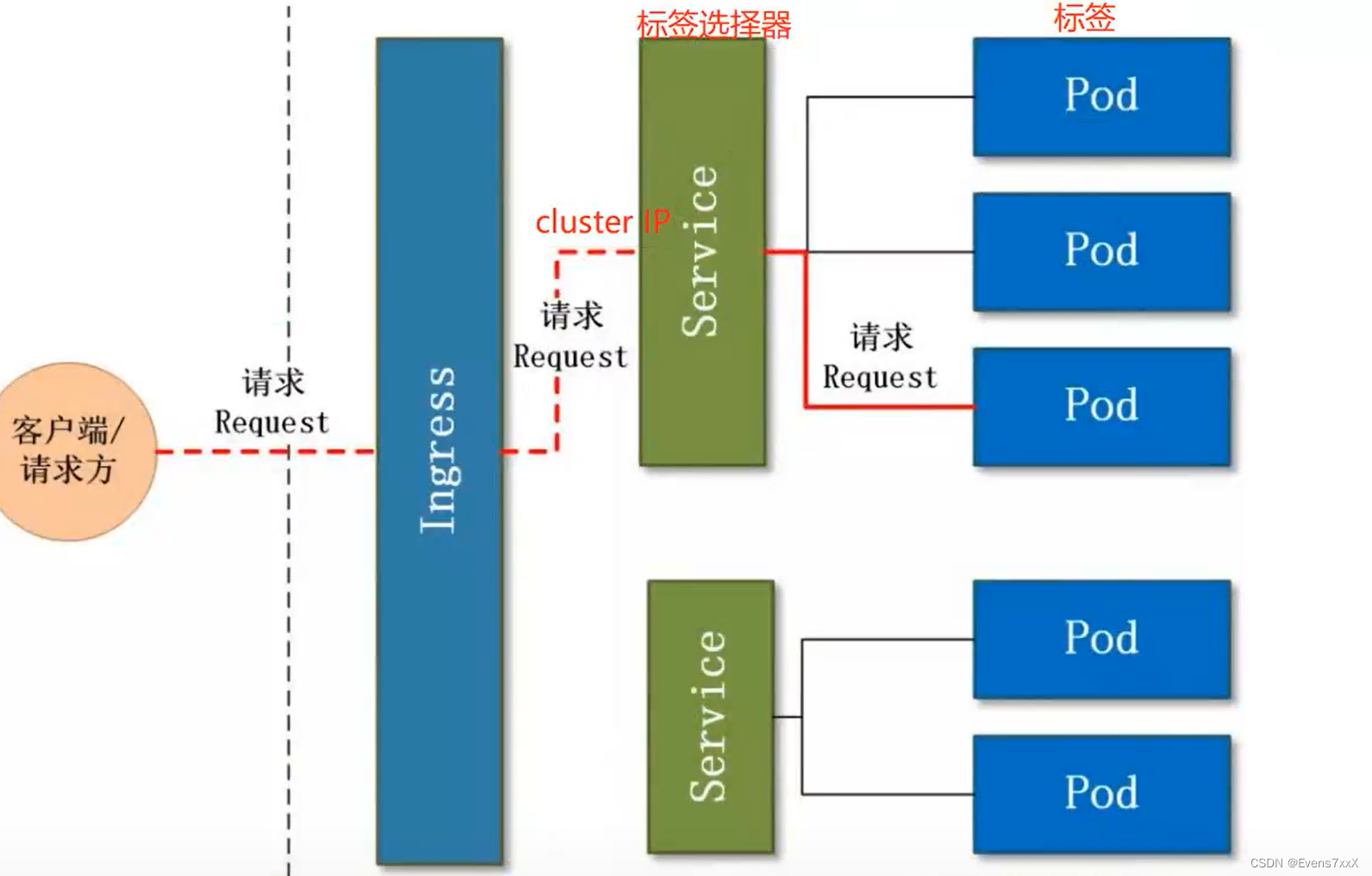


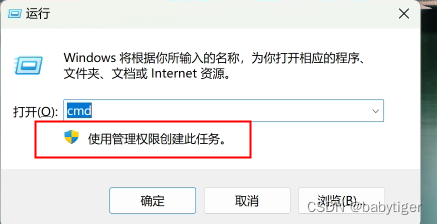



![java八股文面试[JVM]——如何打破双亲委派模型](https://img-blog.csdnimg.cn/a4a4ac9fbf4641c18bf2ba6f0802b8ce.png)
